FIN203 Report: Deregulation and Transformation of Australian Finance
VerifiedAdded on 2022/11/26
|13
|3296
|65
Report
AI Summary
This report provides an in-depth analysis of the Australian financial sector's deregulation, which began in the 1980s. It examines the shift from government control to a more competitive market, focusing on the impact on non-bank financial institutions, such as credit unions and building societies. The report explores the strategic responses of these institutions to deregulation, including branding changes, mergers, and the transition into full-fledged banks. It discusses the rationale behind these changes, highlighting the increased competition and the desire to expand services. The report also analyzes the implications of these transformations for the Australian financial landscape and the sector's contribution to the Gross Domestic Product (GDP). It also looks at the roles of institutions like Heritage Bank and Defence Bank. The report concludes with recommendations based on the observed trends and their implications for the future of the financial sector.
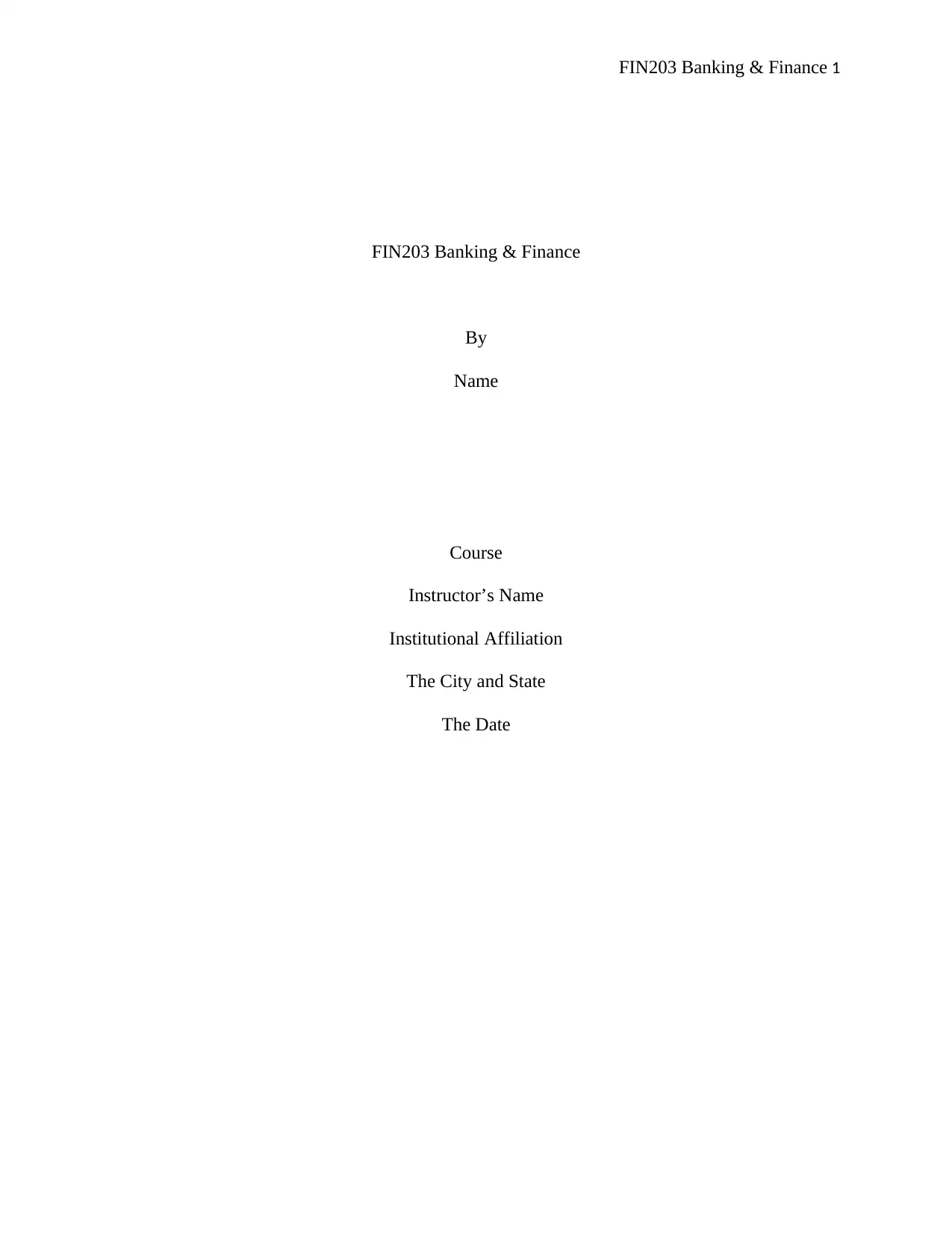
FIN203 Banking & Finance 1
FIN203 Banking & Finance
By
Name
Course
Instructor’s Name
Institutional Affiliation
The City and State
The Date
FIN203 Banking & Finance
By
Name
Course
Instructor’s Name
Institutional Affiliation
The City and State
The Date
Paraphrase This Document
Need a fresh take? Get an instant paraphrase of this document with our AI Paraphraser
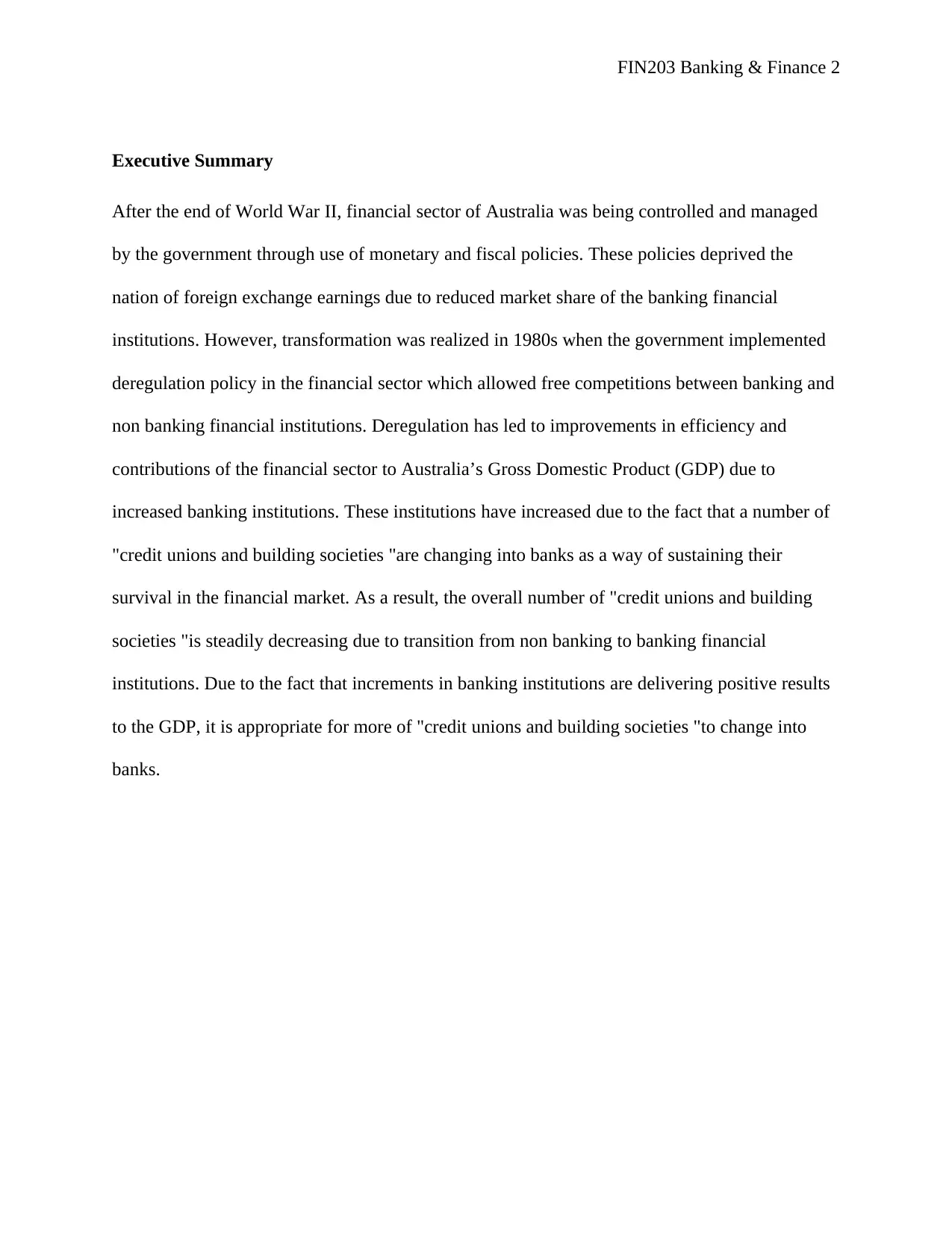
FIN203 Banking & Finance 2
Executive Summary
After the end of World War II, financial sector of Australia was being controlled and managed
by the government through use of monetary and fiscal policies. These policies deprived the
nation of foreign exchange earnings due to reduced market share of the banking financial
institutions. However, transformation was realized in 1980s when the government implemented
deregulation policy in the financial sector which allowed free competitions between banking and
non banking financial institutions. Deregulation has led to improvements in efficiency and
contributions of the financial sector to Australia’s Gross Domestic Product (GDP) due to
increased banking institutions. These institutions have increased due to the fact that a number of
"credit unions and building societies "are changing into banks as a way of sustaining their
survival in the financial market. As a result, the overall number of "credit unions and building
societies "is steadily decreasing due to transition from non banking to banking financial
institutions. Due to the fact that increments in banking institutions are delivering positive results
to the GDP, it is appropriate for more of "credit unions and building societies "to change into
banks.
Executive Summary
After the end of World War II, financial sector of Australia was being controlled and managed
by the government through use of monetary and fiscal policies. These policies deprived the
nation of foreign exchange earnings due to reduced market share of the banking financial
institutions. However, transformation was realized in 1980s when the government implemented
deregulation policy in the financial sector which allowed free competitions between banking and
non banking financial institutions. Deregulation has led to improvements in efficiency and
contributions of the financial sector to Australia’s Gross Domestic Product (GDP) due to
increased banking institutions. These institutions have increased due to the fact that a number of
"credit unions and building societies "are changing into banks as a way of sustaining their
survival in the financial market. As a result, the overall number of "credit unions and building
societies "is steadily decreasing due to transition from non banking to banking financial
institutions. Due to the fact that increments in banking institutions are delivering positive results
to the GDP, it is appropriate for more of "credit unions and building societies "to change into
banks.
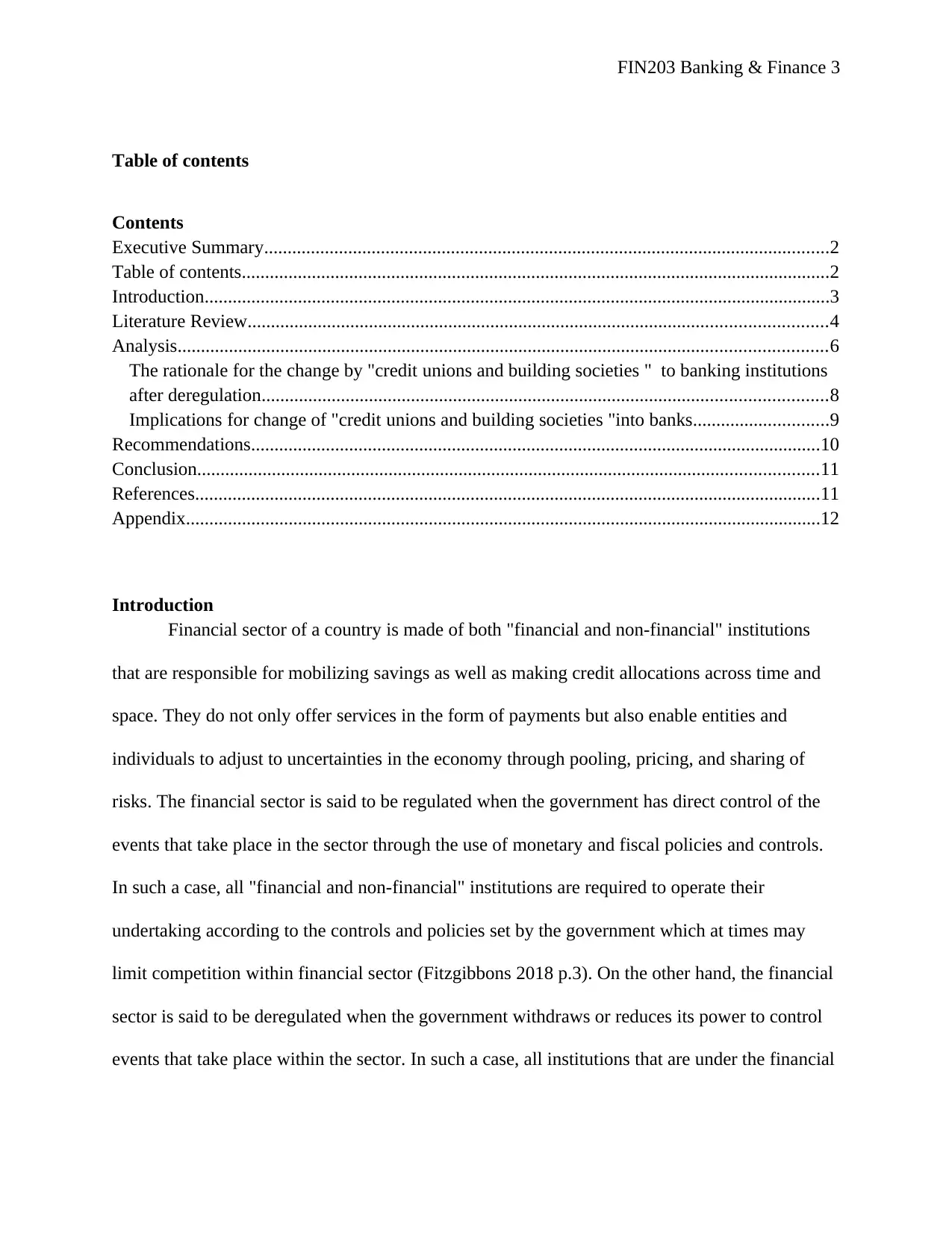
FIN203 Banking & Finance 3
Table of contents
Contents
Executive Summary.........................................................................................................................2
Table of contents..............................................................................................................................2
Introduction......................................................................................................................................3
Literature Review............................................................................................................................4
Analysis...........................................................................................................................................6
The rationale for the change by "credit unions and building societies " to banking institutions
after deregulation.........................................................................................................................8
Implications for change of "credit unions and building societies "into banks.............................9
Recommendations..........................................................................................................................10
Conclusion.....................................................................................................................................11
References......................................................................................................................................11
Appendix........................................................................................................................................12
Introduction
Financial sector of a country is made of both "financial and non-financial" institutions
that are responsible for mobilizing savings as well as making credit allocations across time and
space. They do not only offer services in the form of payments but also enable entities and
individuals to adjust to uncertainties in the economy through pooling, pricing, and sharing of
risks. The financial sector is said to be regulated when the government has direct control of the
events that take place in the sector through the use of monetary and fiscal policies and controls.
In such a case, all "financial and non-financial" institutions are required to operate their
undertaking according to the controls and policies set by the government which at times may
limit competition within financial sector (Fitzgibbons 2018 p.3). On the other hand, the financial
sector is said to be deregulated when the government withdraws or reduces its power to control
events that take place within the sector. In such a case, all institutions that are under the financial
Table of contents
Contents
Executive Summary.........................................................................................................................2
Table of contents..............................................................................................................................2
Introduction......................................................................................................................................3
Literature Review............................................................................................................................4
Analysis...........................................................................................................................................6
The rationale for the change by "credit unions and building societies " to banking institutions
after deregulation.........................................................................................................................8
Implications for change of "credit unions and building societies "into banks.............................9
Recommendations..........................................................................................................................10
Conclusion.....................................................................................................................................11
References......................................................................................................................................11
Appendix........................................................................................................................................12
Introduction
Financial sector of a country is made of both "financial and non-financial" institutions
that are responsible for mobilizing savings as well as making credit allocations across time and
space. They do not only offer services in the form of payments but also enable entities and
individuals to adjust to uncertainties in the economy through pooling, pricing, and sharing of
risks. The financial sector is said to be regulated when the government has direct control of the
events that take place in the sector through the use of monetary and fiscal policies and controls.
In such a case, all "financial and non-financial" institutions are required to operate their
undertaking according to the controls and policies set by the government which at times may
limit competition within financial sector (Fitzgibbons 2018 p.3). On the other hand, the financial
sector is said to be deregulated when the government withdraws or reduces its power to control
events that take place within the sector. In such a case, all institutions that are under the financial
⊘ This is a preview!⊘
Do you want full access?
Subscribe today to unlock all pages.

Trusted by 1+ million students worldwide
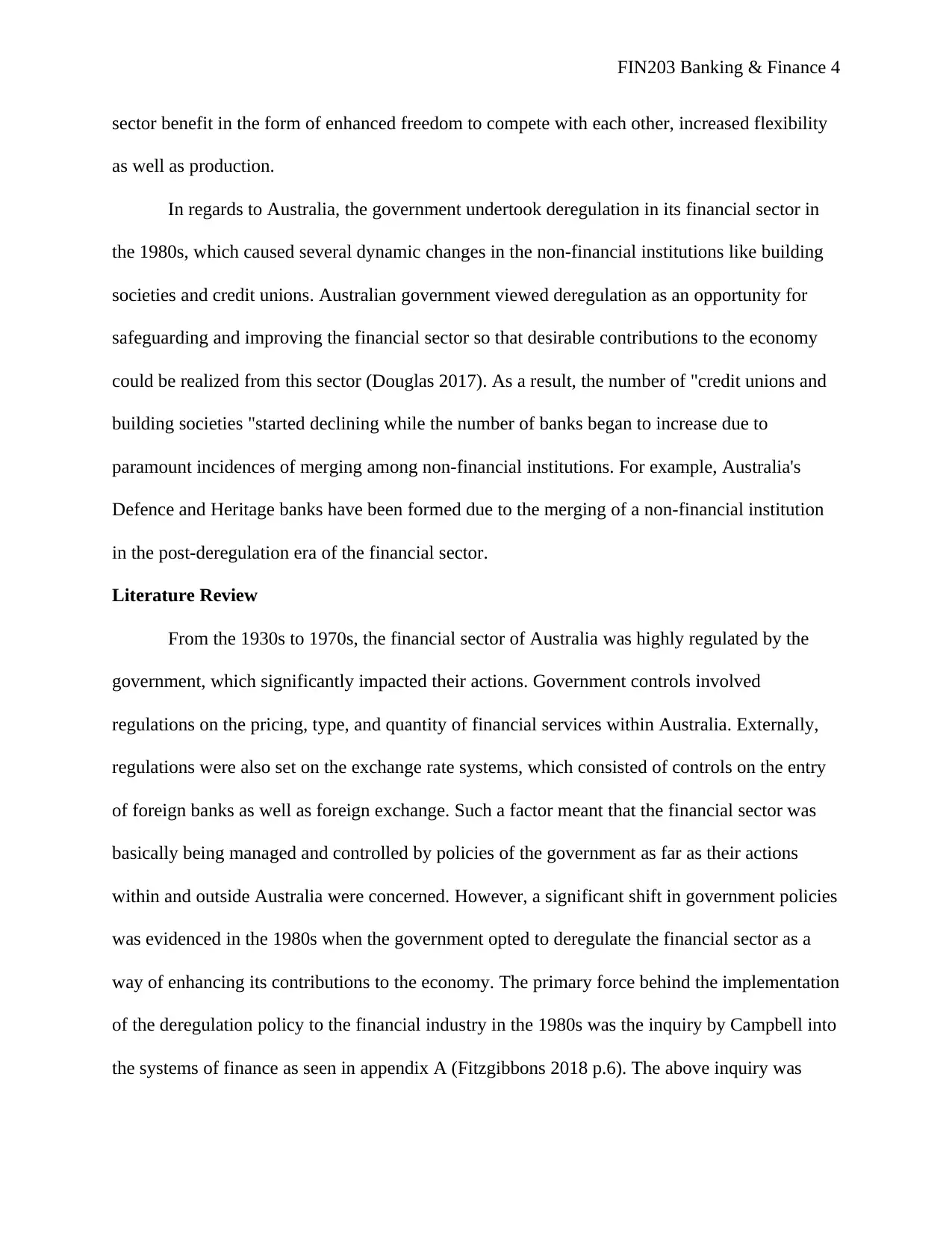
FIN203 Banking & Finance 4
sector benefit in the form of enhanced freedom to compete with each other, increased flexibility
as well as production.
In regards to Australia, the government undertook deregulation in its financial sector in
the 1980s, which caused several dynamic changes in the non-financial institutions like building
societies and credit unions. Australian government viewed deregulation as an opportunity for
safeguarding and improving the financial sector so that desirable contributions to the economy
could be realized from this sector (Douglas 2017). As a result, the number of "credit unions and
building societies "started declining while the number of banks began to increase due to
paramount incidences of merging among non-financial institutions. For example, Australia's
Defence and Heritage banks have been formed due to the merging of a non-financial institution
in the post-deregulation era of the financial sector.
Literature Review
From the 1930s to 1970s, the financial sector of Australia was highly regulated by the
government, which significantly impacted their actions. Government controls involved
regulations on the pricing, type, and quantity of financial services within Australia. Externally,
regulations were also set on the exchange rate systems, which consisted of controls on the entry
of foreign banks as well as foreign exchange. Such a factor meant that the financial sector was
basically being managed and controlled by policies of the government as far as their actions
within and outside Australia were concerned. However, a significant shift in government policies
was evidenced in the 1980s when the government opted to deregulate the financial sector as a
way of enhancing its contributions to the economy. The primary force behind the implementation
of the deregulation policy to the financial industry in the 1980s was the inquiry by Campbell into
the systems of finance as seen in appendix A (Fitzgibbons 2018 p.6). The above inquiry was
sector benefit in the form of enhanced freedom to compete with each other, increased flexibility
as well as production.
In regards to Australia, the government undertook deregulation in its financial sector in
the 1980s, which caused several dynamic changes in the non-financial institutions like building
societies and credit unions. Australian government viewed deregulation as an opportunity for
safeguarding and improving the financial sector so that desirable contributions to the economy
could be realized from this sector (Douglas 2017). As a result, the number of "credit unions and
building societies "started declining while the number of banks began to increase due to
paramount incidences of merging among non-financial institutions. For example, Australia's
Defence and Heritage banks have been formed due to the merging of a non-financial institution
in the post-deregulation era of the financial sector.
Literature Review
From the 1930s to 1970s, the financial sector of Australia was highly regulated by the
government, which significantly impacted their actions. Government controls involved
regulations on the pricing, type, and quantity of financial services within Australia. Externally,
regulations were also set on the exchange rate systems, which consisted of controls on the entry
of foreign banks as well as foreign exchange. Such a factor meant that the financial sector was
basically being managed and controlled by policies of the government as far as their actions
within and outside Australia were concerned. However, a significant shift in government policies
was evidenced in the 1980s when the government opted to deregulate the financial sector as a
way of enhancing its contributions to the economy. The primary force behind the implementation
of the deregulation policy to the financial industry in the 1980s was the inquiry by Campbell into
the systems of finance as seen in appendix A (Fitzgibbons 2018 p.6). The above inquiry was
Paraphrase This Document
Need a fresh take? Get an instant paraphrase of this document with our AI Paraphraser
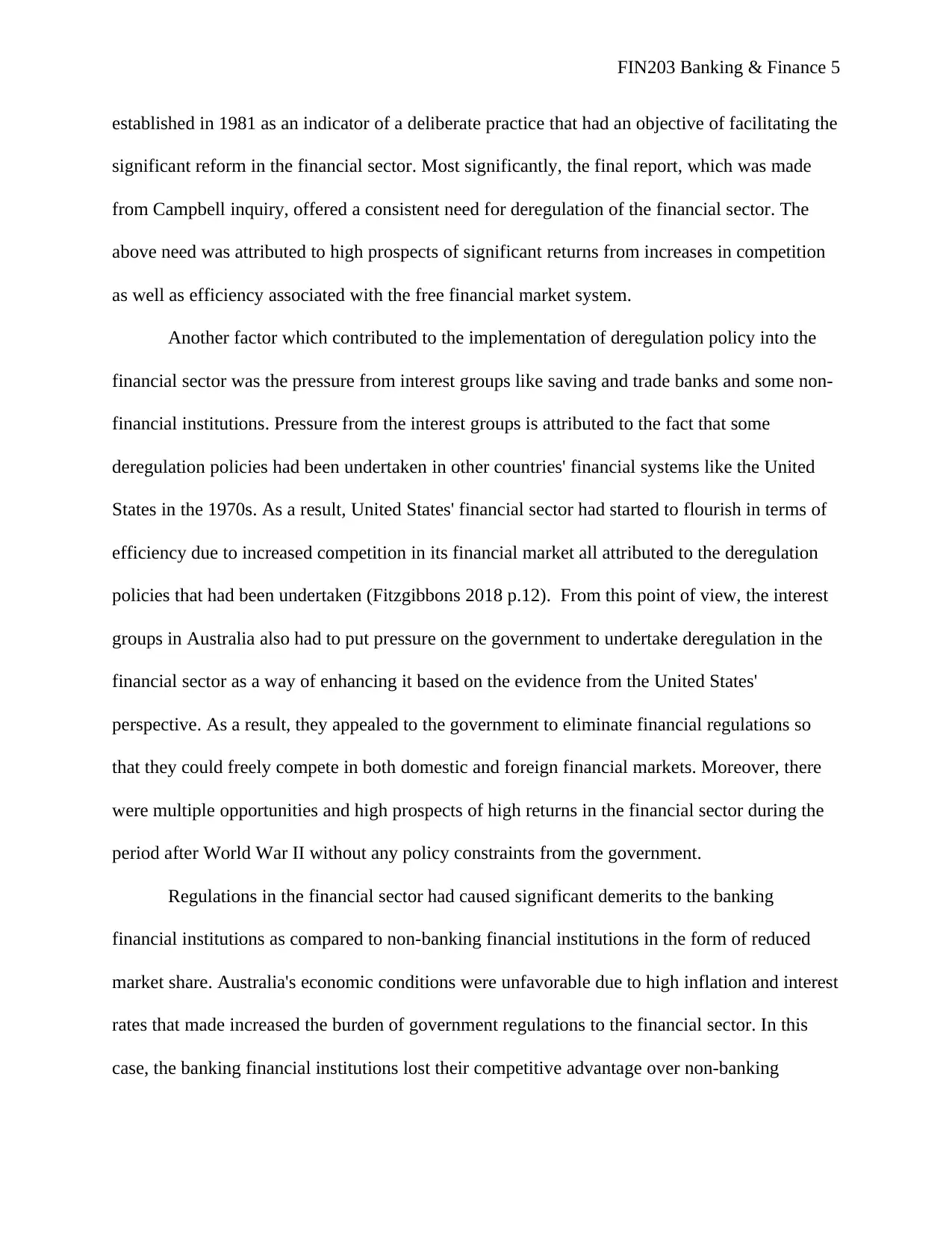
FIN203 Banking & Finance 5
established in 1981 as an indicator of a deliberate practice that had an objective of facilitating the
significant reform in the financial sector. Most significantly, the final report, which was made
from Campbell inquiry, offered a consistent need for deregulation of the financial sector. The
above need was attributed to high prospects of significant returns from increases in competition
as well as efficiency associated with the free financial market system.
Another factor which contributed to the implementation of deregulation policy into the
financial sector was the pressure from interest groups like saving and trade banks and some non-
financial institutions. Pressure from the interest groups is attributed to the fact that some
deregulation policies had been undertaken in other countries' financial systems like the United
States in the 1970s. As a result, United States' financial sector had started to flourish in terms of
efficiency due to increased competition in its financial market all attributed to the deregulation
policies that had been undertaken (Fitzgibbons 2018 p.12). From this point of view, the interest
groups in Australia also had to put pressure on the government to undertake deregulation in the
financial sector as a way of enhancing it based on the evidence from the United States'
perspective. As a result, they appealed to the government to eliminate financial regulations so
that they could freely compete in both domestic and foreign financial markets. Moreover, there
were multiple opportunities and high prospects of high returns in the financial sector during the
period after World War II without any policy constraints from the government.
Regulations in the financial sector had caused significant demerits to the banking
financial institutions as compared to non-banking financial institutions in the form of reduced
market share. Australia's economic conditions were unfavorable due to high inflation and interest
rates that made increased the burden of government regulations to the financial sector. In this
case, the banking financial institutions lost their competitive advantage over non-banking
established in 1981 as an indicator of a deliberate practice that had an objective of facilitating the
significant reform in the financial sector. Most significantly, the final report, which was made
from Campbell inquiry, offered a consistent need for deregulation of the financial sector. The
above need was attributed to high prospects of significant returns from increases in competition
as well as efficiency associated with the free financial market system.
Another factor which contributed to the implementation of deregulation policy into the
financial sector was the pressure from interest groups like saving and trade banks and some non-
financial institutions. Pressure from the interest groups is attributed to the fact that some
deregulation policies had been undertaken in other countries' financial systems like the United
States in the 1970s. As a result, United States' financial sector had started to flourish in terms of
efficiency due to increased competition in its financial market all attributed to the deregulation
policies that had been undertaken (Fitzgibbons 2018 p.12). From this point of view, the interest
groups in Australia also had to put pressure on the government to undertake deregulation in the
financial sector as a way of enhancing it based on the evidence from the United States'
perspective. As a result, they appealed to the government to eliminate financial regulations so
that they could freely compete in both domestic and foreign financial markets. Moreover, there
were multiple opportunities and high prospects of high returns in the financial sector during the
period after World War II without any policy constraints from the government.
Regulations in the financial sector had caused significant demerits to the banking
financial institutions as compared to non-banking financial institutions in the form of reduced
market share. Australia's economic conditions were unfavorable due to high inflation and interest
rates that made increased the burden of government regulations to the financial sector. In this
case, the banking financial institutions lost their competitive advantage over non-banking
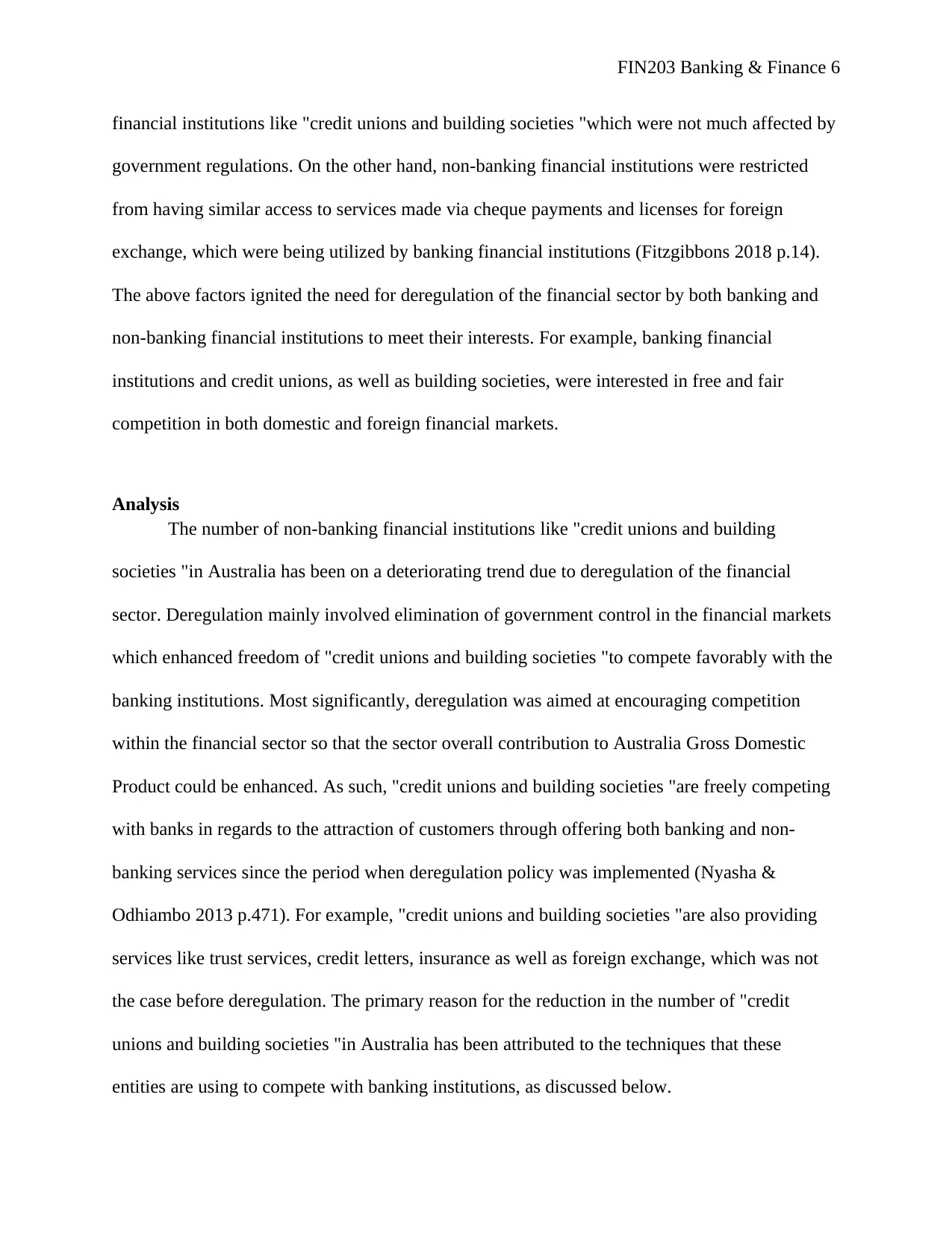
FIN203 Banking & Finance 6
financial institutions like "credit unions and building societies "which were not much affected by
government regulations. On the other hand, non-banking financial institutions were restricted
from having similar access to services made via cheque payments and licenses for foreign
exchange, which were being utilized by banking financial institutions (Fitzgibbons 2018 p.14).
The above factors ignited the need for deregulation of the financial sector by both banking and
non-banking financial institutions to meet their interests. For example, banking financial
institutions and credit unions, as well as building societies, were interested in free and fair
competition in both domestic and foreign financial markets.
Analysis
The number of non-banking financial institutions like "credit unions and building
societies "in Australia has been on a deteriorating trend due to deregulation of the financial
sector. Deregulation mainly involved elimination of government control in the financial markets
which enhanced freedom of "credit unions and building societies "to compete favorably with the
banking institutions. Most significantly, deregulation was aimed at encouraging competition
within the financial sector so that the sector overall contribution to Australia Gross Domestic
Product could be enhanced. As such, "credit unions and building societies "are freely competing
with banks in regards to the attraction of customers through offering both banking and non-
banking services since the period when deregulation policy was implemented (Nyasha &
Odhiambo 2013 p.471). For example, "credit unions and building societies "are also providing
services like trust services, credit letters, insurance as well as foreign exchange, which was not
the case before deregulation. The primary reason for the reduction in the number of "credit
unions and building societies "in Australia has been attributed to the techniques that these
entities are using to compete with banking institutions, as discussed below.
financial institutions like "credit unions and building societies "which were not much affected by
government regulations. On the other hand, non-banking financial institutions were restricted
from having similar access to services made via cheque payments and licenses for foreign
exchange, which were being utilized by banking financial institutions (Fitzgibbons 2018 p.14).
The above factors ignited the need for deregulation of the financial sector by both banking and
non-banking financial institutions to meet their interests. For example, banking financial
institutions and credit unions, as well as building societies, were interested in free and fair
competition in both domestic and foreign financial markets.
Analysis
The number of non-banking financial institutions like "credit unions and building
societies "in Australia has been on a deteriorating trend due to deregulation of the financial
sector. Deregulation mainly involved elimination of government control in the financial markets
which enhanced freedom of "credit unions and building societies "to compete favorably with the
banking institutions. Most significantly, deregulation was aimed at encouraging competition
within the financial sector so that the sector overall contribution to Australia Gross Domestic
Product could be enhanced. As such, "credit unions and building societies "are freely competing
with banks in regards to the attraction of customers through offering both banking and non-
banking services since the period when deregulation policy was implemented (Nyasha &
Odhiambo 2013 p.471). For example, "credit unions and building societies "are also providing
services like trust services, credit letters, insurance as well as foreign exchange, which was not
the case before deregulation. The primary reason for the reduction in the number of "credit
unions and building societies "in Australia has been attributed to the techniques that these
entities are using to compete with banking institutions, as discussed below.
⊘ This is a preview!⊘
Do you want full access?
Subscribe today to unlock all pages.

Trusted by 1+ million students worldwide
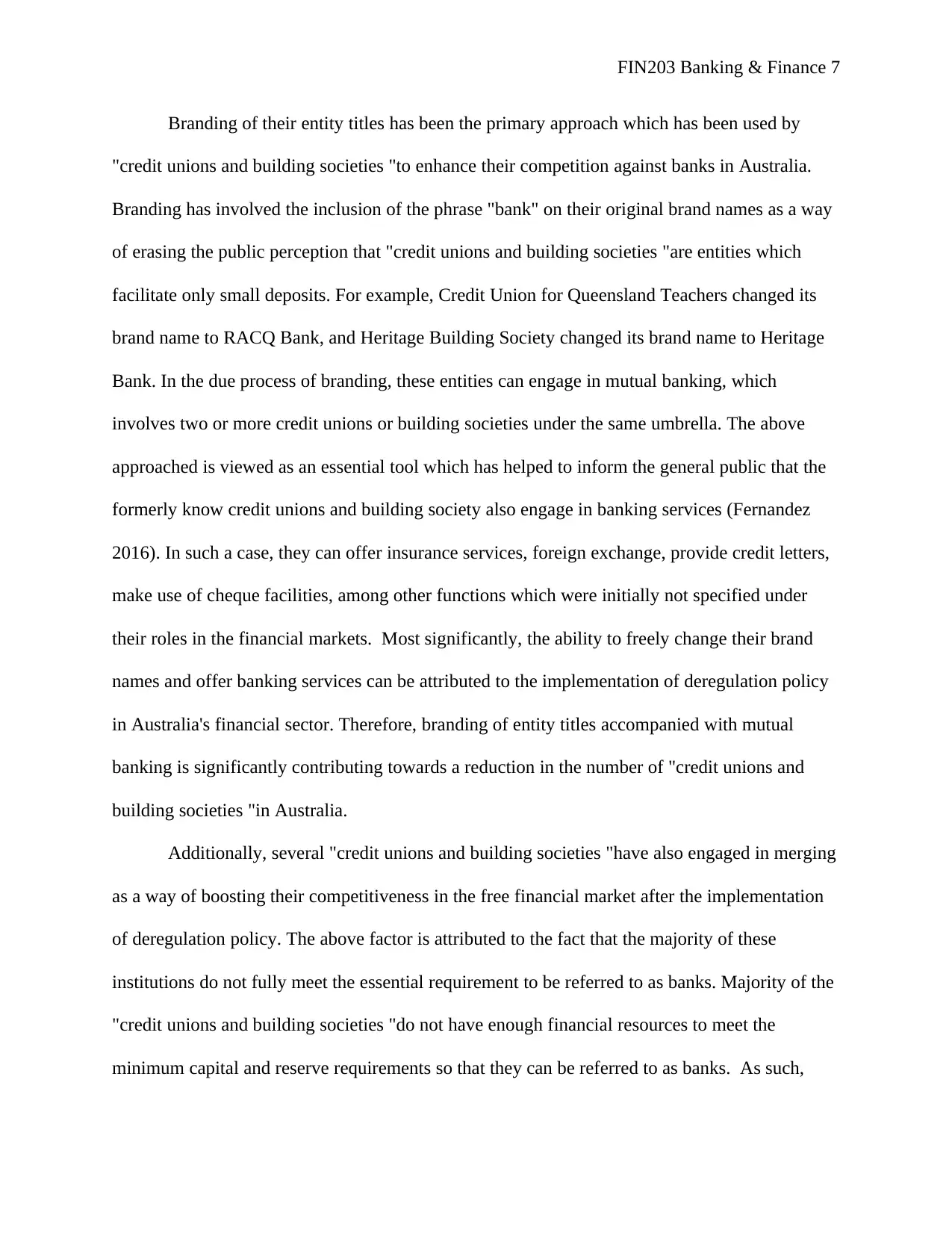
FIN203 Banking & Finance 7
Branding of their entity titles has been the primary approach which has been used by
"credit unions and building societies "to enhance their competition against banks in Australia.
Branding has involved the inclusion of the phrase "bank" on their original brand names as a way
of erasing the public perception that "credit unions and building societies "are entities which
facilitate only small deposits. For example, Credit Union for Queensland Teachers changed its
brand name to RACQ Bank, and Heritage Building Society changed its brand name to Heritage
Bank. In the due process of branding, these entities can engage in mutual banking, which
involves two or more credit unions or building societies under the same umbrella. The above
approached is viewed as an essential tool which has helped to inform the general public that the
formerly know credit unions and building society also engage in banking services (Fernandez
2016). In such a case, they can offer insurance services, foreign exchange, provide credit letters,
make use of cheque facilities, among other functions which were initially not specified under
their roles in the financial markets. Most significantly, the ability to freely change their brand
names and offer banking services can be attributed to the implementation of deregulation policy
in Australia's financial sector. Therefore, branding of entity titles accompanied with mutual
banking is significantly contributing towards a reduction in the number of "credit unions and
building societies "in Australia.
Additionally, several "credit unions and building societies "have also engaged in merging
as a way of boosting their competitiveness in the free financial market after the implementation
of deregulation policy. The above factor is attributed to the fact that the majority of these
institutions do not fully meet the essential requirement to be referred to as banks. Majority of the
"credit unions and building societies "do not have enough financial resources to meet the
minimum capital and reserve requirements so that they can be referred to as banks. As such,
Branding of their entity titles has been the primary approach which has been used by
"credit unions and building societies "to enhance their competition against banks in Australia.
Branding has involved the inclusion of the phrase "bank" on their original brand names as a way
of erasing the public perception that "credit unions and building societies "are entities which
facilitate only small deposits. For example, Credit Union for Queensland Teachers changed its
brand name to RACQ Bank, and Heritage Building Society changed its brand name to Heritage
Bank. In the due process of branding, these entities can engage in mutual banking, which
involves two or more credit unions or building societies under the same umbrella. The above
approached is viewed as an essential tool which has helped to inform the general public that the
formerly know credit unions and building society also engage in banking services (Fernandez
2016). In such a case, they can offer insurance services, foreign exchange, provide credit letters,
make use of cheque facilities, among other functions which were initially not specified under
their roles in the financial markets. Most significantly, the ability to freely change their brand
names and offer banking services can be attributed to the implementation of deregulation policy
in Australia's financial sector. Therefore, branding of entity titles accompanied with mutual
banking is significantly contributing towards a reduction in the number of "credit unions and
building societies "in Australia.
Additionally, several "credit unions and building societies "have also engaged in merging
as a way of boosting their competitiveness in the free financial market after the implementation
of deregulation policy. The above factor is attributed to the fact that the majority of these
institutions do not fully meet the essential requirement to be referred to as banks. Majority of the
"credit unions and building societies "do not have enough financial resources to meet the
minimum capital and reserve requirements so that they can be referred to as banks. As such,
Paraphrase This Document
Need a fresh take? Get an instant paraphrase of this document with our AI Paraphraser
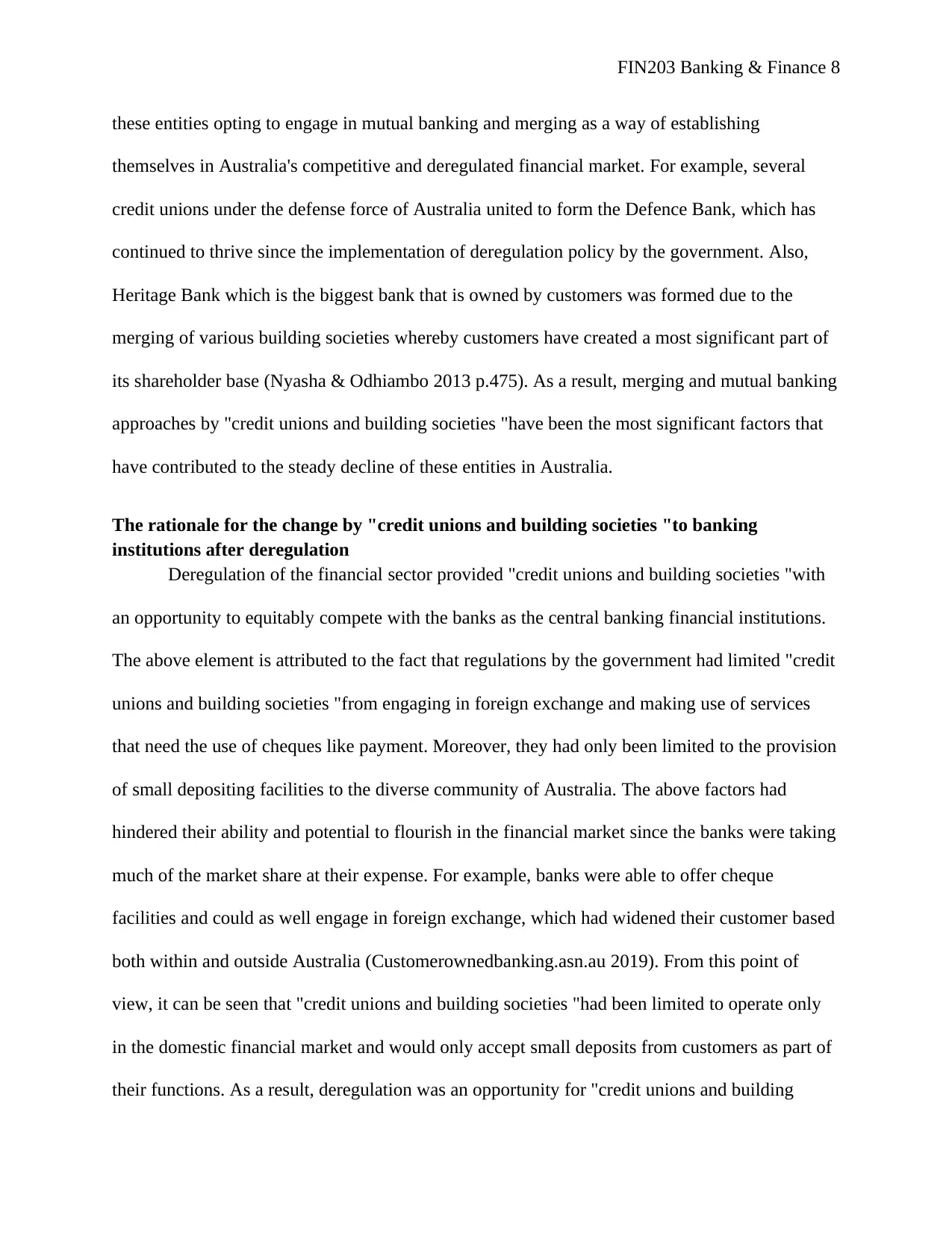
FIN203 Banking & Finance 8
these entities opting to engage in mutual banking and merging as a way of establishing
themselves in Australia's competitive and deregulated financial market. For example, several
credit unions under the defense force of Australia united to form the Defence Bank, which has
continued to thrive since the implementation of deregulation policy by the government. Also,
Heritage Bank which is the biggest bank that is owned by customers was formed due to the
merging of various building societies whereby customers have created a most significant part of
its shareholder base (Nyasha & Odhiambo 2013 p.475). As a result, merging and mutual banking
approaches by "credit unions and building societies "have been the most significant factors that
have contributed to the steady decline of these entities in Australia.
The rationale for the change by "credit unions and building societies "to banking
institutions after deregulation
Deregulation of the financial sector provided "credit unions and building societies "with
an opportunity to equitably compete with the banks as the central banking financial institutions.
The above element is attributed to the fact that regulations by the government had limited "credit
unions and building societies "from engaging in foreign exchange and making use of services
that need the use of cheques like payment. Moreover, they had only been limited to the provision
of small depositing facilities to the diverse community of Australia. The above factors had
hindered their ability and potential to flourish in the financial market since the banks were taking
much of the market share at their expense. For example, banks were able to offer cheque
facilities and could as well engage in foreign exchange, which had widened their customer based
both within and outside Australia (Customerownedbanking.asn.au 2019). From this point of
view, it can be seen that "credit unions and building societies "had been limited to operate only
in the domestic financial market and would only accept small deposits from customers as part of
their functions. As a result, deregulation was an opportunity for "credit unions and building
these entities opting to engage in mutual banking and merging as a way of establishing
themselves in Australia's competitive and deregulated financial market. For example, several
credit unions under the defense force of Australia united to form the Defence Bank, which has
continued to thrive since the implementation of deregulation policy by the government. Also,
Heritage Bank which is the biggest bank that is owned by customers was formed due to the
merging of various building societies whereby customers have created a most significant part of
its shareholder base (Nyasha & Odhiambo 2013 p.475). As a result, merging and mutual banking
approaches by "credit unions and building societies "have been the most significant factors that
have contributed to the steady decline of these entities in Australia.
The rationale for the change by "credit unions and building societies "to banking
institutions after deregulation
Deregulation of the financial sector provided "credit unions and building societies "with
an opportunity to equitably compete with the banks as the central banking financial institutions.
The above element is attributed to the fact that regulations by the government had limited "credit
unions and building societies "from engaging in foreign exchange and making use of services
that need the use of cheques like payment. Moreover, they had only been limited to the provision
of small depositing facilities to the diverse community of Australia. The above factors had
hindered their ability and potential to flourish in the financial market since the banks were taking
much of the market share at their expense. For example, banks were able to offer cheque
facilities and could as well engage in foreign exchange, which had widened their customer based
both within and outside Australia (Customerownedbanking.asn.au 2019). From this point of
view, it can be seen that "credit unions and building societies "had been limited to operate only
in the domestic financial market and would only accept small deposits from customers as part of
their functions. As a result, deregulation was an opportunity for "credit unions and building
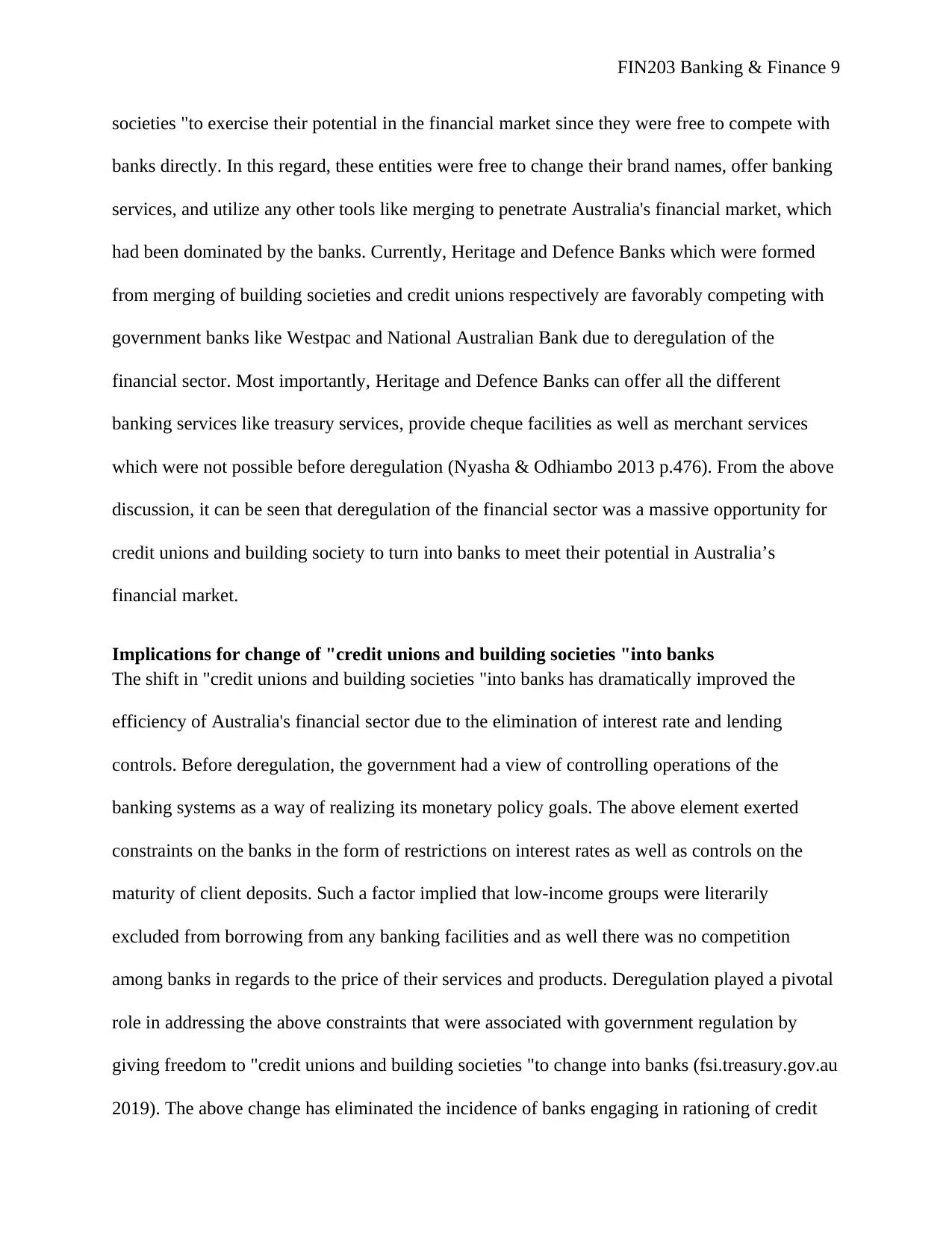
FIN203 Banking & Finance 9
societies "to exercise their potential in the financial market since they were free to compete with
banks directly. In this regard, these entities were free to change their brand names, offer banking
services, and utilize any other tools like merging to penetrate Australia's financial market, which
had been dominated by the banks. Currently, Heritage and Defence Banks which were formed
from merging of building societies and credit unions respectively are favorably competing with
government banks like Westpac and National Australian Bank due to deregulation of the
financial sector. Most importantly, Heritage and Defence Banks can offer all the different
banking services like treasury services, provide cheque facilities as well as merchant services
which were not possible before deregulation (Nyasha & Odhiambo 2013 p.476). From the above
discussion, it can be seen that deregulation of the financial sector was a massive opportunity for
credit unions and building society to turn into banks to meet their potential in Australia’s
financial market.
Implications for change of "credit unions and building societies "into banks
The shift in "credit unions and building societies "into banks has dramatically improved the
efficiency of Australia's financial sector due to the elimination of interest rate and lending
controls. Before deregulation, the government had a view of controlling operations of the
banking systems as a way of realizing its monetary policy goals. The above element exerted
constraints on the banks in the form of restrictions on interest rates as well as controls on the
maturity of client deposits. Such a factor implied that low-income groups were literarily
excluded from borrowing from any banking facilities and as well there was no competition
among banks in regards to the price of their services and products. Deregulation played a pivotal
role in addressing the above constraints that were associated with government regulation by
giving freedom to "credit unions and building societies "to change into banks (fsi.treasury.gov.au
2019). The above change has eliminated the incidence of banks engaging in rationing of credit
societies "to exercise their potential in the financial market since they were free to compete with
banks directly. In this regard, these entities were free to change their brand names, offer banking
services, and utilize any other tools like merging to penetrate Australia's financial market, which
had been dominated by the banks. Currently, Heritage and Defence Banks which were formed
from merging of building societies and credit unions respectively are favorably competing with
government banks like Westpac and National Australian Bank due to deregulation of the
financial sector. Most importantly, Heritage and Defence Banks can offer all the different
banking services like treasury services, provide cheque facilities as well as merchant services
which were not possible before deregulation (Nyasha & Odhiambo 2013 p.476). From the above
discussion, it can be seen that deregulation of the financial sector was a massive opportunity for
credit unions and building society to turn into banks to meet their potential in Australia’s
financial market.
Implications for change of "credit unions and building societies "into banks
The shift in "credit unions and building societies "into banks has dramatically improved the
efficiency of Australia's financial sector due to the elimination of interest rate and lending
controls. Before deregulation, the government had a view of controlling operations of the
banking systems as a way of realizing its monetary policy goals. The above element exerted
constraints on the banks in the form of restrictions on interest rates as well as controls on the
maturity of client deposits. Such a factor implied that low-income groups were literarily
excluded from borrowing from any banking facilities and as well there was no competition
among banks in regards to the price of their services and products. Deregulation played a pivotal
role in addressing the above constraints that were associated with government regulation by
giving freedom to "credit unions and building societies "to change into banks (fsi.treasury.gov.au
2019). The above change has eliminated the incidence of banks engaging in rationing of credit
⊘ This is a preview!⊘
Do you want full access?
Subscribe today to unlock all pages.

Trusted by 1+ million students worldwide
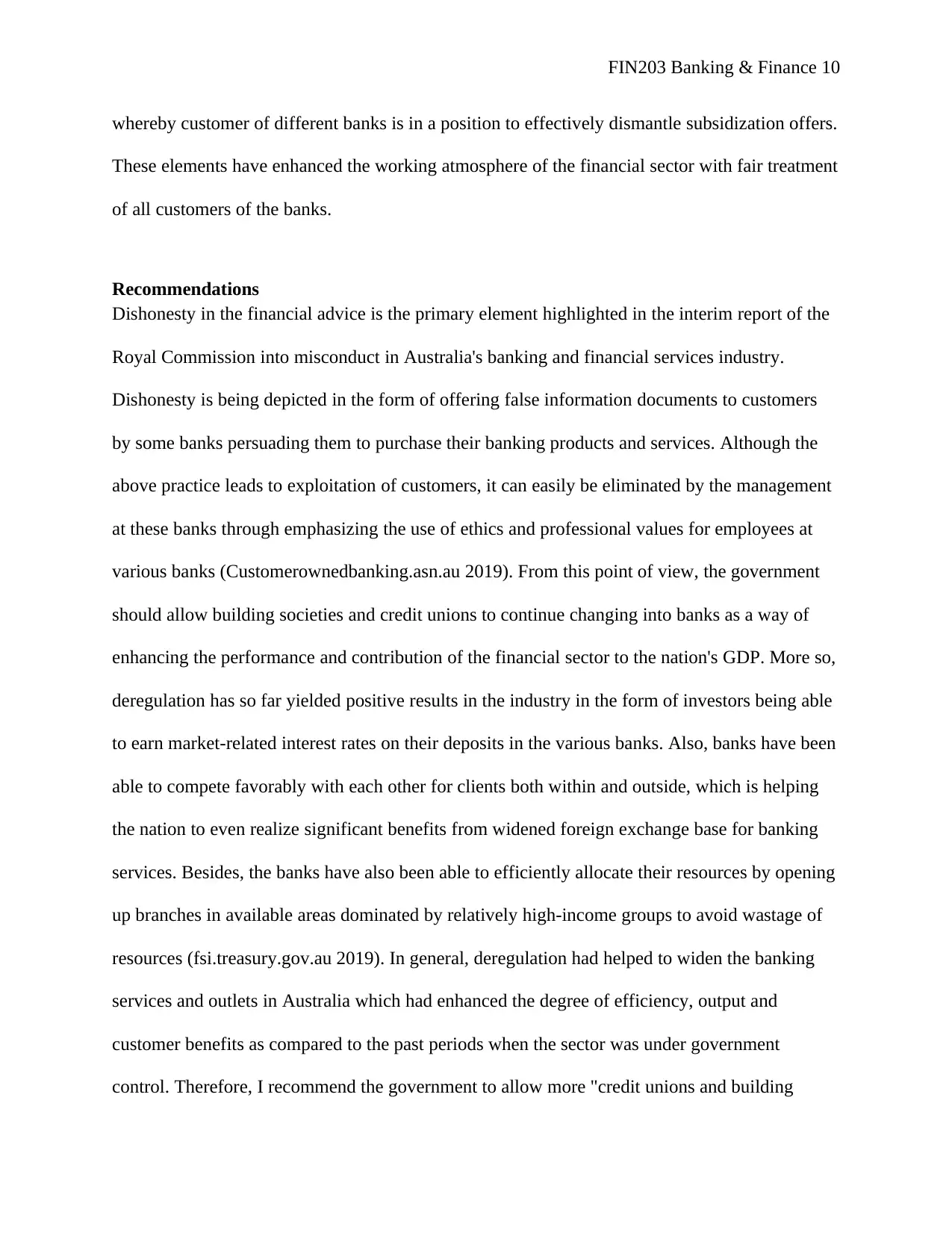
FIN203 Banking & Finance 10
whereby customer of different banks is in a position to effectively dismantle subsidization offers.
These elements have enhanced the working atmosphere of the financial sector with fair treatment
of all customers of the banks.
Recommendations
Dishonesty in the financial advice is the primary element highlighted in the interim report of the
Royal Commission into misconduct in Australia's banking and financial services industry.
Dishonesty is being depicted in the form of offering false information documents to customers
by some banks persuading them to purchase their banking products and services. Although the
above practice leads to exploitation of customers, it can easily be eliminated by the management
at these banks through emphasizing the use of ethics and professional values for employees at
various banks (Customerownedbanking.asn.au 2019). From this point of view, the government
should allow building societies and credit unions to continue changing into banks as a way of
enhancing the performance and contribution of the financial sector to the nation's GDP. More so,
deregulation has so far yielded positive results in the industry in the form of investors being able
to earn market-related interest rates on their deposits in the various banks. Also, banks have been
able to compete favorably with each other for clients both within and outside, which is helping
the nation to even realize significant benefits from widened foreign exchange base for banking
services. Besides, the banks have also been able to efficiently allocate their resources by opening
up branches in available areas dominated by relatively high-income groups to avoid wastage of
resources (fsi.treasury.gov.au 2019). In general, deregulation had helped to widen the banking
services and outlets in Australia which had enhanced the degree of efficiency, output and
customer benefits as compared to the past periods when the sector was under government
control. Therefore, I recommend the government to allow more "credit unions and building
whereby customer of different banks is in a position to effectively dismantle subsidization offers.
These elements have enhanced the working atmosphere of the financial sector with fair treatment
of all customers of the banks.
Recommendations
Dishonesty in the financial advice is the primary element highlighted in the interim report of the
Royal Commission into misconduct in Australia's banking and financial services industry.
Dishonesty is being depicted in the form of offering false information documents to customers
by some banks persuading them to purchase their banking products and services. Although the
above practice leads to exploitation of customers, it can easily be eliminated by the management
at these banks through emphasizing the use of ethics and professional values for employees at
various banks (Customerownedbanking.asn.au 2019). From this point of view, the government
should allow building societies and credit unions to continue changing into banks as a way of
enhancing the performance and contribution of the financial sector to the nation's GDP. More so,
deregulation has so far yielded positive results in the industry in the form of investors being able
to earn market-related interest rates on their deposits in the various banks. Also, banks have been
able to compete favorably with each other for clients both within and outside, which is helping
the nation to even realize significant benefits from widened foreign exchange base for banking
services. Besides, the banks have also been able to efficiently allocate their resources by opening
up branches in available areas dominated by relatively high-income groups to avoid wastage of
resources (fsi.treasury.gov.au 2019). In general, deregulation had helped to widen the banking
services and outlets in Australia which had enhanced the degree of efficiency, output and
customer benefits as compared to the past periods when the sector was under government
control. Therefore, I recommend the government to allow more "credit unions and building
Paraphrase This Document
Need a fresh take? Get an instant paraphrase of this document with our AI Paraphraser

FIN203 Banking & Finance 11
societies "to change into banks as a way of enhancing the contributions of the financial sector to
its economy.
Conclusion
In the post world war II period, Australia's financial sector had been constrained, but the
government regulations in the form of monetary and fiscal policies. The industry had failed to
realize its potential because of the government controls, which had significantly reduced the
market share of the banking financial institutions as compared to non-banking financial
institutions. Moreover, it was the banking financial institutions that had dominated the
commercial market, which meant that the country was missing out on several benefits like
earnings from foreign exchange. However, the step to implement deregulation was vital for
transforming its financial sector, which has resulted in increased banking services, investors,
customer benefits, as well as foreign exchange earnings. The above benefits are attributed to the
fact that the majority of the "credit unions and building societies "are changing into banks as a
way of establishing themselves in the competitive financial market. Therefore, more "credit
unions and building societies "should be allowed to change into banks provided they meet the
minimum capital and reserve requirements as a way of enhancing the performance of the
financial sector.
References
Customerownedbanking.asn.au., 2019. Do credit unions, mutual building societies and mutual
banks offer the same kind of products as banks: Retrieved from
http://www.customerownedbanking.asn.au/consumers/faqs/212-do-credit-unions-mutual-
building-societies-and-mutual-banks-offer-the-same-kind-of-products-as-banks
societies "to change into banks as a way of enhancing the contributions of the financial sector to
its economy.
Conclusion
In the post world war II period, Australia's financial sector had been constrained, but the
government regulations in the form of monetary and fiscal policies. The industry had failed to
realize its potential because of the government controls, which had significantly reduced the
market share of the banking financial institutions as compared to non-banking financial
institutions. Moreover, it was the banking financial institutions that had dominated the
commercial market, which meant that the country was missing out on several benefits like
earnings from foreign exchange. However, the step to implement deregulation was vital for
transforming its financial sector, which has resulted in increased banking services, investors,
customer benefits, as well as foreign exchange earnings. The above benefits are attributed to the
fact that the majority of the "credit unions and building societies "are changing into banks as a
way of establishing themselves in the competitive financial market. Therefore, more "credit
unions and building societies "should be allowed to change into banks provided they meet the
minimum capital and reserve requirements as a way of enhancing the performance of the
financial sector.
References
Customerownedbanking.asn.au., 2019. Do credit unions, mutual building societies and mutual
banks offer the same kind of products as banks: Retrieved from
http://www.customerownedbanking.asn.au/consumers/faqs/212-do-credit-unions-mutual-
building-societies-and-mutual-banks-offer-the-same-kind-of-products-as-banks
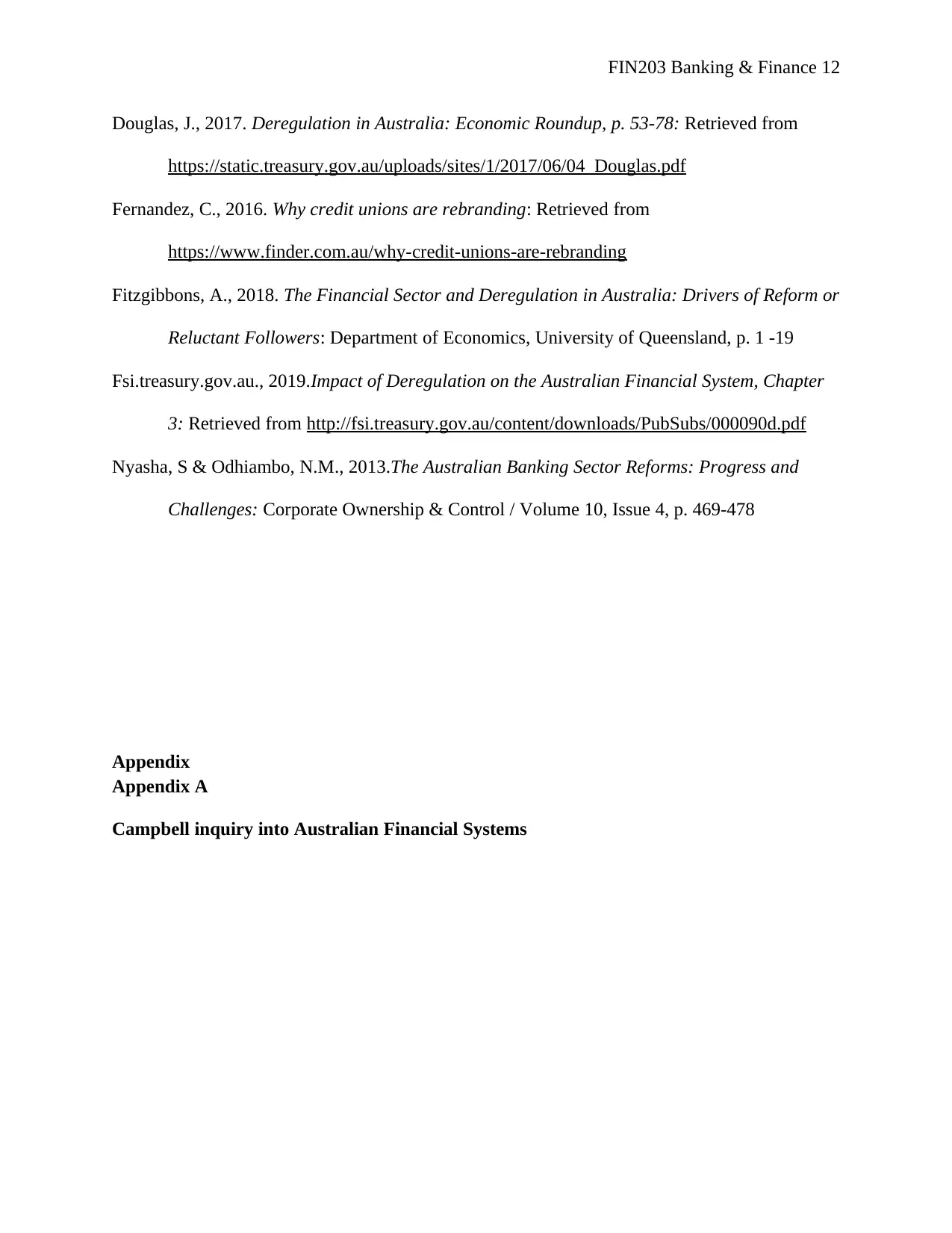
FIN203 Banking & Finance 12
Douglas, J., 2017. Deregulation in Australia: Economic Roundup, p. 53-78: Retrieved from
https://static.treasury.gov.au/uploads/sites/1/2017/06/04_Douglas.pdf
Fernandez, C., 2016. Why credit unions are rebranding: Retrieved from
https://www.finder.com.au/why-credit-unions-are-rebranding
Fitzgibbons, A., 2018. The Financial Sector and Deregulation in Australia: Drivers of Reform or
Reluctant Followers: Department of Economics, University of Queensland, p. 1 -19
Fsi.treasury.gov.au., 2019.Impact of Deregulation on the Australian Financial System, Chapter
3: Retrieved from http://fsi.treasury.gov.au/content/downloads/PubSubs/000090d.pdf
Nyasha, S & Odhiambo, N.M., 2013.The Australian Banking Sector Reforms: Progress and
Challenges: Corporate Ownership & Control / Volume 10, Issue 4, p. 469-478
Appendix
Appendix A
Campbell inquiry into Australian Financial Systems
Douglas, J., 2017. Deregulation in Australia: Economic Roundup, p. 53-78: Retrieved from
https://static.treasury.gov.au/uploads/sites/1/2017/06/04_Douglas.pdf
Fernandez, C., 2016. Why credit unions are rebranding: Retrieved from
https://www.finder.com.au/why-credit-unions-are-rebranding
Fitzgibbons, A., 2018. The Financial Sector and Deregulation in Australia: Drivers of Reform or
Reluctant Followers: Department of Economics, University of Queensland, p. 1 -19
Fsi.treasury.gov.au., 2019.Impact of Deregulation on the Australian Financial System, Chapter
3: Retrieved from http://fsi.treasury.gov.au/content/downloads/PubSubs/000090d.pdf
Nyasha, S & Odhiambo, N.M., 2013.The Australian Banking Sector Reforms: Progress and
Challenges: Corporate Ownership & Control / Volume 10, Issue 4, p. 469-478
Appendix
Appendix A
Campbell inquiry into Australian Financial Systems
⊘ This is a preview!⊘
Do you want full access?
Subscribe today to unlock all pages.

Trusted by 1+ million students worldwide
1 out of 13
Related Documents
Your All-in-One AI-Powered Toolkit for Academic Success.
+13062052269
info@desklib.com
Available 24*7 on WhatsApp / Email
![[object Object]](/_next/static/media/star-bottom.7253800d.svg)
Unlock your academic potential
Copyright © 2020–2025 A2Z Services. All Rights Reserved. Developed and managed by ZUCOL.





